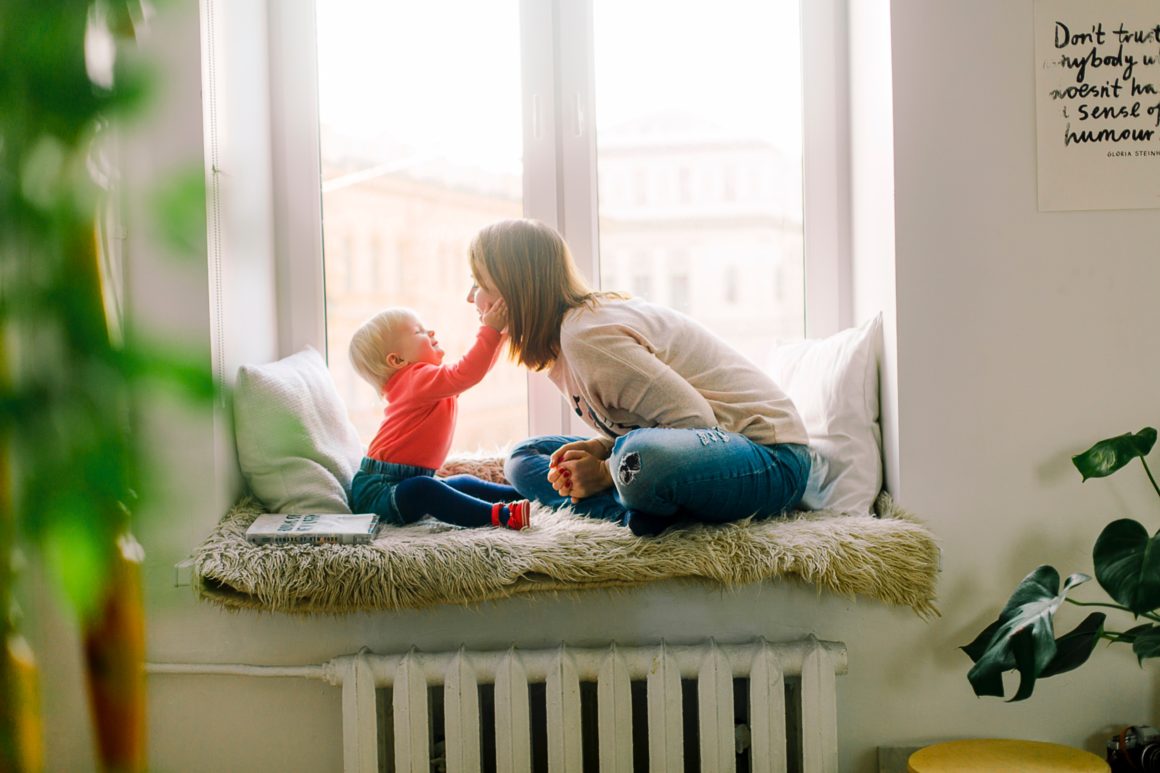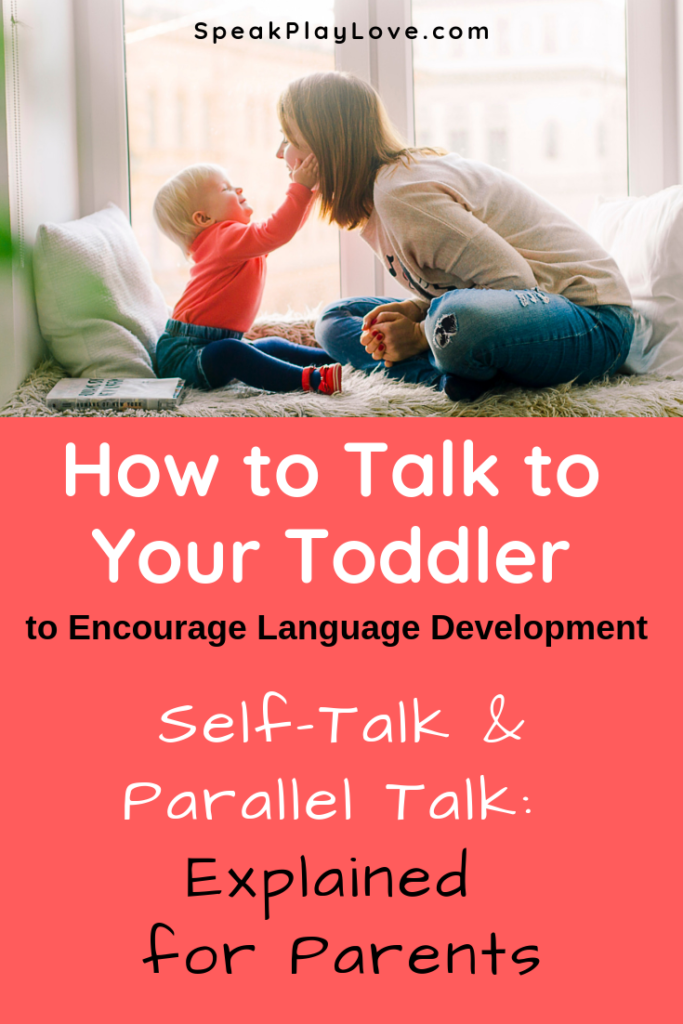
Self-Talk, Parallel Talk and Expansion: Explained for Parents
Before your toddler is even talking, he is a sponge – absorbing everything you say! That’s why it’s important HOW YOU talk to your toddler in order to help him learn to talk. This is especially true if your child is a late talker, has special needs, or is in speech therapy.
Three things that I do with my clients in speech therapy and with my own toddler are called Parallel Talk, Self-Talk and Expansion.
Below I’ll go over each of these ideas – they are really simple to incorporate into your day! And keep reading to learn more about how to determine what level to talk to your child.
Side note: Even if you have a Speech-Language Pathologist that comes to your house every week, the person who is interacting with your child 99% of the time is you!
That means that you need to incorporate the techniques used by your speech therapist into your everyday life to see the results you want. If you have a speech therapist, ask him or her to teach you what they are doing so you can carry over strategies during the week. A good therapist should be thrilled that you want to learn!
RELATED: Grab these Song Choice Cards from my Etsy shop!
This post contains affiliate links, which means we may receive a commission if you click a link and purchase something that we have recommended.
Self-Talk
Self-talk is when you use child-friendly language to narrate what YOU are doing around the house. Talk about what you are touching, seeing, feeling, smelling, hearing, etc. Sounds pretty easy, right? It is!

Lunch Time Example: “Here’s the peas. I’m putting peas on your plate. The plate goes on your tray. It’s time to eat!”
Bath Time Example: “Pour water. Soap on. Rinse off the soap. All done!”
(Looking for more ways to increase language development during bath time? Check out this article.)
RELATED: 7 Tips to Encourage Language Development During Bath Time
Parallel Talk
Parallel talk is when you use child-friendly language to narrate what YOUR CHILD is doing. Talk about what he is touching, seeing, feeling, smelling, and hearing. Think of yourself as a sports caster. This is great to do when you are down on the floor playing with your little one.
 My daughter loves it when I narrate what she is doing. It tends to make her more engaged in the activity, and as a bonus, she will often play longer with that activity! I think that when I spend time on the floor with a certain toy or activity, it also fosters more interest for later independent play with that toy, which is nice for when you need to get some stuff done!
My daughter loves it when I narrate what she is doing. It tends to make her more engaged in the activity, and as a bonus, she will often play longer with that activity! I think that when I spend time on the floor with a certain toy or activity, it also fosters more interest for later independent play with that toy, which is nice for when you need to get some stuff done!
Example: “Oh you have a car! It’s a blue car. Push the car. Vrrooom. The car went fast!”
Things to keep in mind when you are using self-talk and parallel talk:
- Narrate activities that are interesting to your child in that moment. If she is looking around and thinking about something else, then save your breath. This is a “child-directed” activity, which means you’re not forcing your agenda on her.
- Self-talk for short bursts of time throughout the day – don’t self-talk constantly or you’ll just sound like the parent from the Muppet Babies (wha wah wah wha) to your child. Again, watch your child and if she is interested in something, tell her about it!
- Don’t expect your child to repeat you. Right now you are filling her bucket, so that later she can use the language she has stored there.
- Use child-friendly, short sentences. Instead of “Right now I am folding the pink, striped shirt so that you have clothes to wear tomorrow to daycare.” Try saying, “I’m folding clothes” and “Here’s a pink shirt!” See the section below for more on talking at the right level for you child.

RELATED: Practice Vocabulary with these Printable Sorting Mats in my Etsy Shop!
Expansion:
If your child is beginning to speak, you can encourage him by repeating what he said with one extra detail or a in a more complete structure – like a short sentence or phrase. Again, don’t expect your child to repeat you. The key here is acknowledging what he said and then modeling vocabulary and structure he can use in the future. For Example:
- If you child says, “Dog!” You can say, “Yes, big dog!”
- If your child says, “Dog woof” You can say, “Dog says woof!”
Talking to Your Child at the Right Level:
Try to narrate one, small level above where your child is talking.
*Note: This is not to say that you have to talk in single-words/short phrases all the time around your child – just do this with some key words a few times throughout the day. He needs to hear you speak in a normal, adult way too. (And your adult friends and family will appreciate it too!) By hearing you talk throughout the day to others, your child will be learning the foundations of intonation (how your voice goes up and down when you talk), so that is important too!
If he is not talking yet, narrate using 1-2 words at a time.
Lunch Example:
 When you get out the container of peas and show her say, “Peas.”
When you get out the container of peas and show her say, “Peas.”
When you scoop peas to put on her tray say, “Scoop.”
When she takes a bite and likes it say, “Yum!”
When she is continuing to eat her lunch say, “You’re eating!”
If he is saying single words, then you want to narrate 2-3 words as a model. He doesn’t have to repeat you yet!
Example:
When you get out the container of peas and show her say, “Peas for lunch.”
When you scoop peas to put on her tray say, “Scoop the peas.”
When she takes a bite and likes it say, “Yummy peas!”
When she is continuing to eat her lunch say, “Eating lunch!”
*At this stage, there is often still a lot of whining since they are learning when using words is useful! I tend to say, “Use your words.” And then say a word they can repeat. So if Sylvie seems to want more to eat, I’ll just say, “more,” and wait for her to repeat it before giving her more of what she wanted.
If he is saying short phrases, then narrate in full sentences. You’ll want to add information about
- Where: “I put the fork on the table“
- When: “We’ll have ice cream after dinner”
- Details like colors, amounts, and how things feel: “This ice is so cold“
Hope this was helpful! Please browse our detailed activity ideas where you can test out some of the above strategies.
RELATED: Practice Vocabulary with these Printable Sorting Mats in my Etsy Shop!
RELATED: Ice Sensory Play for Early Language Learning
RELATED: Recommended Toys for Interactive Play and Language Development
RELATED: Check out my Etsy Shop for Children’s printable activities!
If you have any questions, please comment below! I love to hear from readers.
Pin It for Later!




6 Comments
Pingback:
Pingback:
Sam Gibson
I appreciate your tip about adding a little extra detail or word to what your child just said to help them expand their vocabulary. My sister is concerned that her two-year-old son might have a speech impediment. She’s hoping to find an experienced professional that she can work with to see if there’s more she can be doing or more efficient techniques.
preschool learning videos
amazing article for preschool
Karissa
Wonderful article! Do you have a printable version that I could send home with my preschool students as they head out for summer break!?
Margaret Feldmann, M.S., CCC-SLP
thank you so much! I don’t have a printable version unfortunately